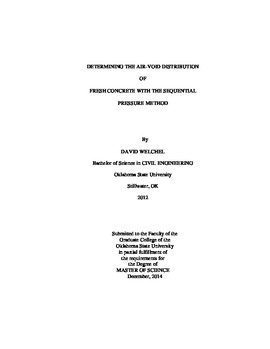| dc.contributor.advisor | Ley, Tyler | |
| dc.contributor.author | Welchel, David Leon | |
| dc.date.accessioned | 2018-04-24T13:02:30Z | |
| dc.date.available | 2018-04-24T13:02:30Z | |
| dc.date.issued | 2014/12/1 | |
| dc.identifier.uri | https://hdl.handle.net/11244/299670 | |
| dc.description.abstract | This work consist of the validation of a novel testing procedure, called the SAM, using sequential pressures. The SAM testing procedure uses a new measurement value, called the SAM number, to determine the quality of the air-void system. This research also looks at the reliability, repeatability, and variability of the SAM testing procedure. This study looked into 9 different mixture types with varying w/cm ratios and admixtures. The difference between identical air entrained (AEA) concrete mixtures with and without polycarboxylates (PC) were also examined by the SAM. Concrete mixtures for this study were made in a climate controlled laboratory environment. All concrete mixtures in this study had hardened air-void analysis (ASTM C 457) conducted in them. The parameters that were determined by ASTM C 457 were then compared to the SAM number. The results of this study show that the SAM provides a good indication of the air-void system, and a SAM number limit of 0.20 psi has been shown to correlate well to a spacing factor of 0.008" or less. The second study in this research shows a possible mechanism for the SAM. This study looked into how air entrained air bubbles reacted to an applied pressure, and these findings were compared to what would be predicted by Boyle's Law, Henry's Law, and the Laplace-Young Equation. This study found that air bubbles dissolved along a linear line that was little affected by the air content in the sample. Also, these air bubbles dissolved approximately in order of size, starting with the smallest first. The study also found that clustered air bubbles behaved differently than bubbles spaced farther apart. This finding is a possible explanation for the SAM testing procedure. The results in this study were also compared to actual concrete testing data. This was done to further show that the phenomenon shown in the research could be happening in actual concrete that is being tested with the SAM. | |
| dc.format | application/pdf | |
| dc.language | en_US | |
| dc.rights | Copyright is held by the author who has granted the Oklahoma State University Library the non-exclusive right to share this material in its institutional repository. Contact Digital Library Services at lib-dls@okstate.edu or 405-744-9161 for the permission policy on the use, reproduction or distribution of this material. | |
| dc.title | Determining the Air-void Distribution of Fresh Concrete with the Sequential Pressure Method | |
| dc.contributor.committeeMember | Russell, Bruce | |
| dc.contributor.committeeMember | Cross, Stephen | |
| osu.filename | Welchel_okstate_0664M_13755.pdf | |
| osu.accesstype | Open Access | |
| dc.description.department | Civil Engineering | |
| dc.type.genre | Thesis | |
| dc.type.material | text | |
